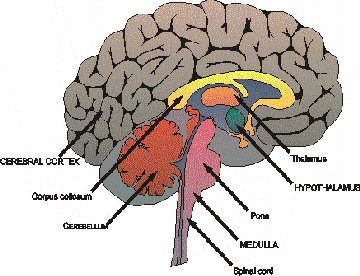- What is Brain tumour (Glioma of the Brain)
- Statistics on Brain tumour (Glioma of the Brain)
- Risk Factors for Brain tumour (Glioma of the Brain)
- Progression of Brain tumour (Glioma of the Brain)
- Symptoms of Brain tumour (Glioma of the Brain)
- Clinical Examination of Brain tumour (Glioma of the Brain)
- How is Brain tumour (Glioma of the Brain) Diagnosed?
- Prognosis of Brain tumour (Glioma of the Brain)
- How is Brain tumour (Glioma of the Brain) Treated?
What is Brain tumour (Glioma of the Brain)

The brain is the control centre for the body. It is comprised of millions of individual nerve cells which are all interconnected. It is located at the top of the spinal cord and is encased in hard bone. Individual nerves emerge from the brain to work the muscles and organs contained within the head. These are called cranial nerves.
The brain itself is divided into 2 sides and each side contains a number of lobes. The frontal lobes control some functions such as memory and learned behaviour, together with some speech functions.The parietal and temporal lobes contain the control centre for movement and sensation on the opposite side of the body. The occipital, located at the back interprets visual signals from the eyes and is therefore responsible for sight. Located underneath the occipital lobes is the cerebellum which controls balance and coordination on the same side of the body.
The brain stem is responsible for automatic functions such as breathing.
Statistics on Brain tumour (Glioma of the Brain)
This type of brain tumour is a malignancy and occurs in childhood or late adulthood, with sex incidence being more common in males.
Geographically, the brain tumour is found worldwide.
Risk Factors for Brain tumour (Glioma of the Brain)
Exposure to radiation increases the risk of this brain tumour. There is no conclusive evidence that mobile phones increase the risk as yet. If a first degree relative has a brain cancer tumour the risk is increased.
Progression of Brain tumour (Glioma of the Brain)
This type of brain tumour spreads by direct local invasion of the surrounding brain tissue. Aggressive tumours may spread by small seedlings floating around the cerebro-spinal fluid and lodging in other parts of the brain.
How is Brain tumour (Glioma of the Brain) Diagnosed?
General investigations into this brain tumour may show very little.
Prognosis of Brain tumour (Glioma of the Brain)
Well differentiated brain tumours may often be cured by surgery and or radiotherapy.
More aggressive brain cancer tumours are less likely to be cured but substantial remissions of several years can be achieved with combination treatment.
The most aggressive form, glioblastoma multiformi, is rarely cured by surgery or radiotherapy and in older age groups life expectancy is often 6 months or less.
How is Brain tumour (Glioma of the Brain) Treated?
Brain tumour treatment usually involves a biopsy and resection of as much tumour as possible, with preservation of normal brain particularly in delicate areas of the brain.
Radiotherapy offers a good option if surgery is not possible and is often given following surgery. Chemotherapy is also given for recurrent brain tumours.
Chemotherapy protocols include:
1) PCV:
Lomustine (CCNU) 110mg/m2 oral day 1 (capsules are 100, 40, 10mg)
Vincristine 1.4mg/m2 ( max 2 mg) I.V. Day 1
Procarbazine 60mg/m2 oral Days 8 to 21 (capsules are 50 mg) (repeat every 4 weeks)
2) Temozolamide 200 mg/m2/day p.o. for 5 days every 4 weeks if no prior chemotherapy, 150 mg/m2/day p.o. for 5 days every 4 weeks if prior chemotherapy.
3) Thalidomide given as a single agent or in combination with chemotherapy (needs ethics committee and SA Govt issued license to prescribe)
100 mg/day starting dose, increase by 100 mg/day each week until 500 mg/day p.o.
Improvement in brain tumour symptoms is an important measurement. Specific monitoring may be by serial imaging of the brain, eg with CT scans or MRI.
The brain tumour symptoms that may require attention are headaches which can be treated with standard analgesics. Headaches should be considered as a visceral pain.
Nausea and vomiting can be of the central vestibular type and should be treated with appropriate anti-nauseants.
Problems with function can be assisted greatly with Physiotherapists and Occupational Therapists.
A variety of equipment is available for the neurologically impaired to make life a little easier.
All content and media on the HealthEngine Blog is created and published online for informational purposes only. It is not intended to be a substitute for professional medical advice and should not be relied on as health or personal advice. Always seek the guidance of your doctor or other qualified health professional with any questions you may have regarding your health or a medical condition. Never disregard the advice of a medical professional, or delay in seeking it because of something you have read on this Website. If you think you may have a medical emergency, call your doctor, go to the nearest hospital emergency department, or call the emergency services immediately.







